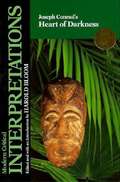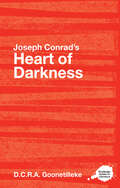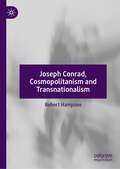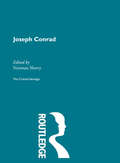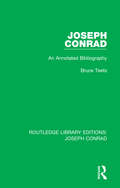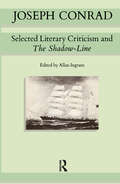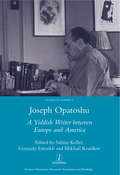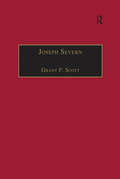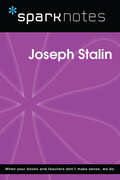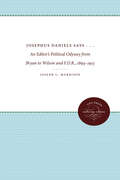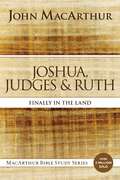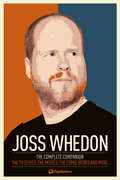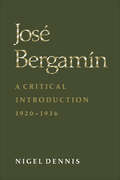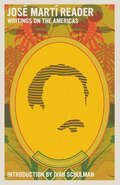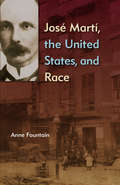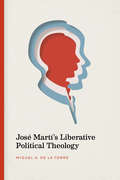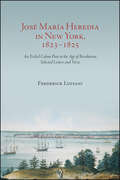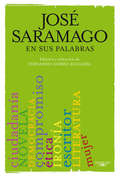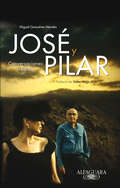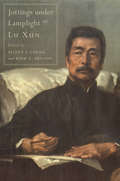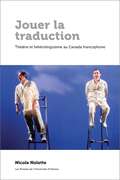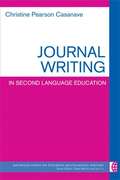- Table View
- List View
Joseph Conrad's Critical Reception
by John G. PetersThroughout the twentieth and twenty-first centuries, Joseph Conrad's novels and short stories have consistently figured into - and helped to define - the dominant trends in literary criticism. This book is the first to provide a thorough yet accessible overview of Conrad scholarship and criticism spanning the entire history of Conrad studies, from the 1895 publication of his first book, Almayer's Folly, to the present. While tracing the general evolution of the commentary surrounding Conrad's work, John G. Peters's careful analysis also evaluates Conrad's impact on critical trends such as the belles lettres tradition, the New Criticism, psychoanalysis, structuralist and post-structuralist criticism, narratology, postcolonial studies, gender and women's studies, and ecocriticism. The breadth and scope of Peters's study make this text an essential resource for Conrad scholars and students of English literature and literary criticism.
Joseph Conrad's Heart of Darkness (Modern Critical Interpretations)
by Harold BloomEssays on Heart of Darkness by Albert J. Guerard, James Guetti, C. B. Cox, Bruce Henricksen, R. A. Gekoski, Ian Watt, John Tessitore, Peter Brooks, and Aaron Fogel.
Joseph Conrad's Heart of Darkness: A Routledge Study Guide (Routledge Guides to Literature)
by D.C.R.A. GoonetillekeJoseph Conrad’s novella, Heart of Darkness, has fascinated critics and readers alike, engaging them in highly controversial debate as it deals with fundamental issues of good and evil, civilisation, race, love and heroism. This classic tale transcends the boundaries of time and place and has inspired famous film and television adaptations emphasising the cultural significance and continued relevance of the book. This guide to Conrad’s captivating novel offers: an accessible introduction to the text and contexts of Heart of Darkness a critical history, surveying the many interpretations of the text from publication to the present a selection of new essays and reprinted critical essays on Heart of Darkness, by Ian Watt, Linda Dryden, Ruth Nadelhaft, J. Hillis Miller and Peter Brooks, providing a range of perspectives on the novel and extending the coverage of key critical approaches identified in the survey section cross-references between sections of the guide, in order to suggest links between texts, contexts and criticism suggestions for further reading. Part of the Routledge Guides to Literature series, this volume is essential reading for all those beginning detailed study of Heart of Darkness and seeking not only a guide to the novel, but a way through the wealth of contextual and critical material that surrounds Conrad's text.
Joseph Conrad, Cosmopolitanism and Transnationalism
by Robert HampsonIn 1908, Joseph Conrad was criticised by a reviewer for being a man ‘without either country or language’: even his shipboard communities were the product of a ‘cosmopolitan’ vision. This book takes off from that criticism and begins by exploring the history and meanings of the term ‘cosmopolitan’. It then considers the multinational world of Conrad’s ships – and of the Merchant Marine more generally – to differentiate multinationalism from cosmopolitanism. Subsequent chapters then address nationalism, nation-formation and the concept of the nation through a reading of Nostromo; cosmopolitanism and internationalism in The Secret Agent; nationalism, internationalism and transnational activism in relation to Under Westen Eyes; and Conrad’s own transnational activism in his later essays. While drawing distinctions between cosmopolitanism, internationalism and transnationalism as the appropriate conceptual framings for Conrad’s works, this book traces Conrad’s own engagement with nationalism, cosmopolitanism, and transnational activism in relation to the political events of his time.
Joseph Conrad: A Commemoration (The\cambridge Edition Of The Works Of Joseph Conrad Ser.)
by Norman SherryJoseph Conrad (1857-1924). Polish born, learnt English from scratch when he arrived in Britain. Writings include: Heart of Darkness, The Secret Agent, Nostromo. Volume covers the period 1895 - 1993. Includes Conrad's responses to his critics.
Joseph Conrad: An Annotated Bibliography (Routledge Library Editions: Joseph Conrad)
by Bruce TeetsOriginally published in 1990, this is a comprehensive and annotated bibliography of the writings on Joseph Conrad and his works. Covering the years from 1895 to 1975 it also includes indexes of authors, secondary works, periodicals and newspapers, foreign languages and primary titles. Part of a series of annotated bibliographies on English Literature in Transition, 1880-1920 this will be a valuable resource for students of literature.
Joseph Conrad: Selected Literary Criticism and The Shadow-Line
by Joseph Conrad Allan IngramFirst Published in 1986. On 22 January 1910, after two years’ work on what he had intended as a break from Chance, Conrad finally finished the manuscript of Under Western Eyes. It had been begun, like many of his novels, as a short story, to be called simply ‘Razumov’, in which he would try ‘to capture the very soul of things Russian’ (Jean-Aubry, 1927, II, p. 64). Some 130,000 words later, Conrad was physically, mentally and emotionally exhausted. This is a collection of correspondence, biography and writing on Joseph Conrad’s work.
Joseph Heller: A Reference Guide
by Brenda KeeganThis book analyzes the trend that differentiates Joseph Heller and other modern writers.
Joseph Opatoshu: A Yiddish Writer Between Europe and America
by Sabine Koller"At the turn of the twentieth century East European Jews underwent a radical cultural transformation, which turned a traditional religious community into a modern nation, struggling to find its place in the world. An important figure in this 'Jewish Renaissance' was the American-Yiddish writer and activist Joseph Opatoshu (1886-1954). Born into a Hassidic family, he spent his early childhood in a forest in Central Poland, was educated in Russia and studied engineering in France and America. In New York, where he emigrated in 1907, he joined the revitalizing modernist group Di yunge - The Young. His early novels painted a vivid picture of social turmoil and inner psychological conflict, using modernist devices of multiple voices and mixed linguistic idioms. He acquired international fame by his historical novels about the Polish uprising of 1863 and the expulsion of Jews from Regensburg in 1519. Though he was translated into several languages, Yiddish writing always fostered his ideas and ideals of Jewish identity. Although he occupied a key position in the transnational Jewish culture during his lifetime, Opatoshu has until recently been neglected by scholars. This volume brings together literary specialists and historians working in Jewish and Slavic Studies, who analyse Opatoshu's quest for modern Jewish identity from different perspectives. The contributors are Shlomo Berger (Amsterdam), Marc Caplan (Baltimore, MD), Gennady Estraikh (New York), Roland Gruschka (Heidelberg), Ellie Kellman (Boston), Sabine Koller (Regensburg), Mikhail Krutikov (Ann Arbor, MI), Joshua Lambert (Amherst, MA), Harriet Murav (Urbana-Champaign, IL), Avrom Novershtern (Jerusalem), Dan Opatoshu (Los Angeles), Eugenia Prokop-Janiec (Krakow), Jan Schwarz (Lund), Astrid Starck (Basel/Mulhouse), Karolina Szymaniak (Krakow) and Evita Wiecki (Munich)."
Joseph Pulitzer: and the New York World
by George JuergensTo determine how and why Pulitzer turned the unsuccessful New York World into the most widely read and probably the most prosperous newspaper in the country, Professor Juergens isolates and analyzes the special qualities of Pulitzer's new style of journalism.
Joseph Severn: Letters and Memoirs (The Nineteenth Century Series)
by Grant F. ScottThis is the first modern scholarly edition of the letters and memoirs of Joseph Severn, English painter and deathbed companion of John Keats. It includes letters from a remarkable collection of never-before-published correspondence held by descendants of the Severn family. Scott's unprecedented access to hundreds of new letters has resulted in a major revisionist work that challenges traditional ideas about Severn's life and character. The edition includes new information about Severn's early artistic success in Italy, an extraordinarily thorough record of his day-to-day activities as a working artist in England, and surprising details about his experience as British Consul in Rome. The volume represents a significant work of recovery, printing in full three important memoirs that have until now appeared only in inaccurate excerpts and offering thirty-three illustrations that demonstrate the range of Severn's talents as a painter. Scott makes a compelling case for a revaluation of Severn, whose friends also included Charles Eastlake, William Gladstone, Leigh Hunt, John Ruskin, and Mary Shelley. This collection will prove valuable not only to literary biographers and Keats scholars, but also to art and cultural historians of the Romantic and Victorian eras. Adding significantly to the volume's usefulness are a detailed chronology of Severn's life and artwork, and appendices containing an index of the newly discovered letters and a ledger of Severn's patrons, paintings and commissions.
Joseph Stalin (SparkNotes Biography Guide)
by SparkNotesJoseph Stalin (SparkNotes Biography Guide) Making the reading experience fun! SparkNotes Biography Guides examine the lives of historical luminaries, from Alexander the Great to Virginia Woolf. Each biography guide includes:An examination of the historical context in which the person lived A summary of the person&’s life and achievements A glossary of important terms, people, and events An in-depth look at the key epochs in the person&’s career Study questions and essay topics A review test Suggestions for further reading Whether you&’re a student of history or just a student cramming for a history exam, SparkNotes Biography guides are a reliable, thorough, and readable resource.
Josephus Daniels Says . . .: An Editor's Political Odyssey from Bryan to Wilson and F.D.R., 1894-1913
by Joseph L. MorrisonIn this study, Morrison traces Daniels's editorial opinions and policies from his early editorial apprenticeship to his appointment as Wilson's secretary of the navy. Morrison sheds light on the relationship between Daniels's editorial views and the various forces active in the state and nation between 1890 and 1912.Originally published in 1962.A UNC Press Enduring Edition -- UNC Press Enduring Editions use the latest in digital technology to make available again books from our distinguished backlist that were previously out of print. These editions are published unaltered from the original, and are presented in affordable paperback formats, bringing readers both historical and cultural value.
Joshua, Judges, and Ruth: Finally in the Land (MacArthur Bible Studies)
by John F. MacArthurIt took more than forty years of wandering, but finally the nation of Israel was ready to enter the land that God had promised them. However, they knew that arriving at the borders was just the beginning, for many battles and many foes still lay ahead. Yet, as Joshua reminded them, they also knew that the Lord had promised to fight all their battles and defeat their foes—through His power, and not their own.In this study, pastor John MacArthur will guide you through an in-depth look at the Israelites' conquest of the Promised Land, beginning with the miraculous parting of the Jordan River, continuing through the victories and setbacks as the people settled into Canaan, and concluding with the time of the judges.Studies include close-up examinations of Rahab, Ruth, and Samson, as well as careful considerations of doctrinal themes such as "The Sin of Achan" and the role of "The Kinsman Redeemer."—ABOUT THE SERIES—The MacArthur Bible Study series is designed to help you study the Word of God with guidance from widely respected pastor and author John MacArthur. Each guide provides intriguing examinations of the whole of Scripture by examining its parts and incorporates:Extensive, but straight-forward commentary on the text.Detailed observations on overriding themes, timelines, history, and context.Word and phrase studies to help you unlock the broader meaning and apply it to your life.Probing, interactive questions with plenty of space to write down your response and thoughts.
Joss Whedon: The Complete Companion
by PopmattersTHE ESSENTIAL UNOFFICIAL GUIDE TO THE WHEDONVERSE Joss Whedon's importance in contemporary pop culture can hardly be overstated, but there has never been a book providing a comprehensive survey of his career as a whole - until now. The Complete Companion covers every aspect of the Whedonverse through insightful essays and interviews, including fascinating conversations with key collaborators Jane Espenson and Tim Minear. Over 40 contributors have been brought together by PopMatters, the acclaimed international magazine of cultural criticism, to provide an irresistible mix of analysis, interpretation and sheer celebration. Whether you're a student looking for critical approaches to Buffy the Vampire Slayer, or a Browncoat who follows Nathan Fillion on Twitter (or, let's face it, both) there is plenty here to enjoy. Covers all the TV series, movies, and comic books, including: Buffy the Vampire Slayer, Angel, Firefly, Dollhouse, Dr. Horrible's Sing-Along Blog, Fray, Astonishing X-Men, The Avengers. . . and more!
José Bergamín: A Critical Introduction, 1920-1936
by Nigel DennisWriter, critic, and cultural activist José Bergamín (1895-1983) was unjustly relegated to the sidelines of contemporary Spanish intellectual life for reasons that have more to do with his political dissidence and long periods of exile than with the interest and importance of his written work. This book represents the first attempt to come to terms with that work. Professor Dennis's study focuses on the period 1920-1936, the so-called silver age of Spanish literature, during which Bergamín rose to prominence alongside a group of superlatively gifted writers and friends, among them Frederico Garcia Lorca, Rafael Alberti, Jorge Guillén, and Pedro Salinas. It sets out to explain the nature of the relationship Bergamín had as a critic and prose writer with the major poets of the 1920s and 1930s, and at the same time systematically examines the singularity of his own work as an aphorist, essayist, and dramatist. Professor Dennis also devotes attention to explaining the sense of Bergamín's initiative in founding the important journal Cruz y Raya (1933-1936) and the role this publication played, both culturally and politically, during the troubled years of the Second Republic. This book not only fills a notable gap in our understanding of pre--Civil War literary and intellectual life in Spain, but also lays the foundation for all future research into the work of this fascinating and enigmatic writer.
José Martí Reader: Writings on the Americas
by José MartíThis anthology of the writing of José Martí&’s features bilingual poetry, political essays, writings on Latin American culture, and his letters.José Martí organized and unified the movement for Cuban independence and died on the battlefield. His dedication to the goal of Cuban freedom made his name a synonym for liberty throughout Latin America.This collection of the writing of José Martí&’s features bilingual poetry, his political essays and writings on culture, and his letters. Readers will discover a literary genius and an insightful political commentator on the troubled relationship between the United States and Latin America.&“Martí was the guide of his time but also stands as the anticipator of ours,&” wrote Cuban revolutionary leader Carlos Rafael Rodríguez. Martí was an outstanding teacher, journalist, poet and revolutionary of his time, able to interweave the threads of Latin American culture and history.
José Martí, the United States, and Race
by Anne Fountain"Essential reading for those who increasingly appreciate the enormous importance of Martí as one of the nineteenth century's most influential and most original thinkers."--John Kirk, coeditor of Redefining Cuban Foreign Policy "Fountain's wide-ranging, keen-eyed, and meticulously researched analysis covers the gamut of race relations that Martí's work probed."--Esther Allen, translator of José Martí: Selected Writings "An engaging, comprehensive, and well-balanced book on Cuba's national hero José Martí. Anne Fountain's chapters on Martí's vision of blacks are an indispensable source of information for anyone interested in the topic."--Jorge Camacho, author of José Martí: las máscaras del escritor A national hero in Cuba and a champion of independence across Latin America, José Martí produced a body of writing that has been theorized, criticized, and politicized. However, one of the most understudied aspects of his work is how his time in the United States affected what he wrote about race and his attitudes toward racial politics. In the United States Martí encountered European immigrants and the labor politics that accompanied them and became aware of the hardships experienced by Chinese workers. He read in newspapers and magazines about the oppression of Native Americans and the adversity faced by newly freed black citizens. Although he'd first witnessed the mistreatment of slaves in Cuba, it was in New York City, near the close of the century, where he penned his famous essay "My Race," declaring that there was only one race, the human race. Anne Fountain argues that it was in the United States that Martí--confronted by the forces of manifest destiny, the influence of race in politics, the legacy of slavery, and the plight and promise of the black Cuban diaspora--fully engaged with the specter of racism. Examining Martí's complete works with a focus on key portions, Fountain reveals the evolution of his thinking on the topic, indicating the significance of his sources, providing a context for his writing, and offering a structure for his works on race. Anne Fountain is professor of Spanish and Latin American studies at San José State University and the author of José Martí and U.S. Writers.
José Martí’s Liberative Political Theology
by Miguel A. De La TorreJosé Martí's Liberative Political Theology argues that Martí's religious views, which at first glance might appear outdated and irrelevant, are actually critical to understanding his social vision. During a time in which the predominant philosophical view was materialistic (e.g., Darwin, Marx), Martí sought to reconcile social and political trends with the metaphysical, believing that ignoring the spiritual would create a soulless approach toward achieving a liberative society. As such, Martí used religious concepts and ideas as tools that could bring forth a more just social order. In short, this book argues Martí could be considered a precursor to what would come to be called liberation theology. Miguel De La Torre has authored the most comprehensive text written thus far concerning Martí's religious views and how they affected his political thought. The few similar texts that exist are written in Spanish, and most of them romanticize Martí's spirituality in an attempt to portray him as a &“Christian believer.&” Only a handful provide an academic investigation of Martí's theological thought based solely on his writings, and those concentrate on just one aspect of Martí's religious influences. José Martí's Liberative Political Theology allows for mutual influence between Martí's political and religious views, rather than assuming one had precedence over the other.
José María Heredia in New York, 1823–1825: An Exiled Cuban Poet in the Age of Revolution, Selected Letters and Verse
by Frederick LucianiThis volume offers the most complete English translation to date of the prose and poetry of José María Heredia (b. Cuba, 1803; d. Mexico, 1839), focusing on Heredia's political exile in the United States from November 1823 to August 1825. Frederick Luciani's introduction offers a complete biographical sketch that discusses the complications of Heredia's life in exile, his conflicted political views, his significance as a travel writer and observer of life in the United States, and his reception by nineteenth-century North American writers and critics. The volume includes thoroughly annotated letters that Heredia wrote to family and friends in Cuba, describing his struggles and adventures living among other young expatriates in New York City—fellow conspirators in a failed plot to overthrow Spanish rule on the island. His travel letters, especially those that describe his trip to the Niagara frontier in 1824 along the Hudson River and the Erie Canal, offer discerning reflections on American landscapes, technological advances, political culture, and social customs. The volume also offers translations of the verse that Heredia composed during his New York exile, in which he gave impassioned voice to Cuba's struggle for independence from Spain, and which reflected the emerging Romantic sensibilities in Spanish-language poetry. With accurate, clear translations, this volume serves as an introduction to a figure who is enshrined in the canon of Latin American literature, but scarcely known to Anglophone readers.
José Saramago en sus palabras
by Fernando Gómez AguileraJosé Saramago en sus palabras.Un catálogo de reflexiones personales, literarias e ideológicas. La intervención en la esfera pública constituye uno de los rasgos centrales del perfil intelectual de José Saramago. Su voz se convirtió en una referencia global, particularmente identificada con el pensamiento crítico, la defensa de los excluidos y la reivindicación de los derechos humanos. La concesión del Premio Nobel de Literatura en 1998 contribuyó a acrecentar el alcance de sus palabras. Este libro constituye un repertorio de declaraciones del autor recogidas en prensa escrita desde la segunda mitad de los años setenta hasta marzo de 2009. Su vertiente de creador de opinión pública queda bien patente en estas páginas, que ahondan en la identidad de José Saramago como persona, como escritor y como ciudadano comprometido. Controvertido y racionalista, sentencioso e imaginativo, original y provocador, político y combativo, Saramago observa, analiza y saca conclusiones poderosas formuladas mediante frases robustas y sugerentes. Unas declaraciones que constituyen hoy un valioso caudal de información y de presentación de ideas y valores éticos, así como un compendio de sabiduría. «En el fondo, todos tenemos necesidad de decir quiénes somos y qué es lo que estamos haciendo, la necesidad de dejar algo hecho, porque esta vida no es eterna y dejar cosas hechas puede ser una forma de eternidad.»José Saramago
José y Pilar: Conversaciones inéditas
by Miguel Gonçalves MendesUn encuentro con el mundo íntimo del gran escritor portugués José Saramago. Durante cuatro años, Miguel Gonçalves Mendes filmó a José Saramago y Pilar del Río en su intimidad de Lanzarote, a lo largo de sus viajes por todo el mundo, en fiestas con amigos y familia. De esa intensa grabación resultaron, primero, la película José y Pilar, y ahora un libro compuesto, esencialmente, de material inédito: horas de conversaciones que exploran grandes cuestiones como la política, el amor, el trabajo, la literatura o la muerte. «La grandeza de Saramago no tiene adjetivos que la definan fielmente, y los que existen se quedan cortos. Tampoco hay palabras para definir con justicia esa sociedad que José y Pilar forman.»Luis Sepúlveda «Me siento orgulloso y agradecido de que ambos me permitieran entrar en sus vidas y compartir momentos inolvidables, donde el dolor, a un ritmo lento e inexorable, se aproximaba, pero el entusiasmo por cambiar las cosas y por luchar estuvieron presentes hasta el final. José Saramago estará allí donde lo necesitemos; sus pensamientos, sus ideas, su vida, su amistad, siempre nos acompañarán. Y Pilar, su traductora, su amiga, su amante, su esposa, su musa, a quien dedicó todas sus obras desde que la conoció, será su legítima representante y continuará con su lucha.»Baltasar Garzón «Observé la manera en la que se dirigía a la gente, sin diferenciar entre la señora que pone el plato en la mesa o el pez gordo condecorado que se sienta bien orgulloso a su lado. Creo que era mi abuela quien decía que la gente ofrece su mejor sonrisa a los suyos y mala cara a los demás. Y en cierto modo, [para Saramago] todos eran de los suyos. Ese toque popular que otorga el nacer entre los más sencillos impide siempre desligarse de la percepción de la diferencia, del desajuste social, y otorga una humildad enorme.»Valter Hugo Mãe
Jottings under Lamplight
by Lu XunLu Xun (1881–1936) is widely considered the greatest writer of twentieth-century China. Although primarily known for his two slim volumes of short fiction, he was a prolific, inventive essayist. These 62 essays—20 translated for the first time—showcase his versatility as a master of prose forms and his brilliance as a cultural critic.
Jouer la traduction: Théâtre et hétérolinguisme au Canada francophone (Regards sur la traduction)
by Nicole NoletteContrairement au théâtre québécois, où le bilinguisme est mis en scène de manière intermittente, celui qui provient de ses marges fait du bilinguisme une pratique courante. Les écrivains franco-canadiens – ceux de l’Ouest canadien, de l’Ontario et de l’Acadie – racontent et montent différentes histoires de diglossie et de bilinguisme et jouent le jeu de la littérature en y démultipliant la traduction dans la forme comme dans le contenu. L’ « hétérolinguisme » – c’est-à-dire l’inscription de la variabilité linguistique – de ces pièces de théâtre franco-canadiennes est le plus souvent compréhensible pour les lecteurs et les publics bilingues locaux. Néanmoins, la diffusion de telles pièces et, par ricochet, leur légitimation auprès des métropoles théâtrales canadiennes au fonctionnement surtout unilingue, auront à passer par des traductions en supplément à celles auxquelles leurs jeux bilingues leur permettent déjà de s’adonner. Il est possible que, pour atteindre la légitimation par les institutions dominantes grâce à la traduction, « les cultures de l’exiguïté sacrifient ce qu’elles possèdent de plus radicalement créateur », c’est-à-dire l’inscription du traduisible et l’hétérolinguisme ludique. De l’autre, parmi les traductions additionnelles qui découlent de ces processus de diffusion et de légitimation, la réinscription supplémentaire ou ludique du traduisible pourrait être tout aussi radicalement créatrice que son inscription première. Une analyse percutante, actuelle, de la circulation, en traduction, de la production théâtrale de l’Ouest canadien francophone, de l’Ontario français et de l’Acadie, qui prend des allures de terrain de jeu pour le français et l’anglais. Publié en français
Journal Writing in Second Language Education
by Christine Pearson CasanaveJournal writing is not new--journals have been around for centuries. More recently, journals have been viewed as a means of scaffolding reflective teaching and encouraging reflectivity in research processes. As a result, some educators may ask, “What more do we need to know?” Those likely to raise this question are probably not thinking of the explosive growth of reflective writing enabled by social networking on the Web, the blogs and other interactive e-vehicles for reflection on experiences in our literate, “real,” and virtual lives This revisiting of journal writing from a 21st century perspective, informed by relevant earlier literature, is what Christine Pearson Casanave guides readers through in this first book-length treatment of the use of journal writing in the contexts of language learning, pre and in-service teaching, and research. Casanave has put together existing ideas that haven't been put together before and has done it not as an edited collection, but as a single-authored book. She has done it in a way that will be especially accessible to teachers in language teacher education programs and to practicing teachers and researchers of writing in both second and foreign language settings, and in a way that will inspire all of us to think about, not just do, journal writing. Those who have never attempted to use journals in their classes and own lives, as well as others who have used it with mixed results, will probably be tempted to try it in at least some of the venues Casanave provides guidance for. Those already committed to journal writing will very likely find in this book new reasons for expanding and enhancing their use of journals.

